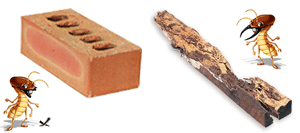Methods of Manufacturing
Clay bricks are formed in a mould (the soft mud method), or more frequently in commercial mass production by extruding clay through a die and then wire-cutting them to the desired size (the stiff mud process). The shaped clay is then dried and fired either by burning in a kiln or sometimes, in warm and sunny countries, by sun-drying to achieve the final, desired strength. The action of heat gives rise to a sintering process that causes the clay particles to fuse and thus develops extremely strong ceramic bonds in the burnt clay bodies. Such bonds are highly stable. As a result, bricks can withstand the severe weathering actions and are inert to almost all normal chemical attacks.Basic Advantages of Brick
- Aesthetic Appeal
- Thermal & Acoustic Insulation
- Zero Maintenance Cost
- Fire Resistance
- Flexible in Application
1. Aesthetic Appeal
Brick possesses natural and infinite pleasant colors of burnt clays. Its color formation is achieved through a complicated physio-chemical reaction during the firing process. In contrast to the color of stained body, brick color is permanent and will not fade during weathering process. Different clay compositions, firing temperatures, or kiln atmosphere can lead to different colors. By proper control of these factors, bricks can be made to exhibit endless variety of natural and attractive colors. Bricks' natural colors combined with the extreme flexibility in applications produce aesthetic results which are always personal and everlasting.
2. Thermal & Acoustic Insulation
 Thermal Insulation: Brick generally exhibits better thermal insulation property than other building materials like concrete. Perforation can improve the thermal insulation property of bricks to some extent. Besides, the Thermal Mass and moisture that the brick has absorbed can help to keep the temperature inside the house relatively constant. In orther words, brick absorbs and releases heat slowly and thus keep the house cool during day-time and warm during night-time.
Thermal Insulation: Brick generally exhibits better thermal insulation property than other building materials like concrete. Perforation can improve the thermal insulation property of bricks to some extent. Besides, the Thermal Mass and moisture that the brick has absorbed can help to keep the temperature inside the house relatively constant. In orther words, brick absorbs and releases heat slowly and thus keep the house cool during day-time and warm during night-time.
Acoustic Insulation: As far as acoustic insulation is concerned, brick wall provides good sound insulation property due to its dense structure. The thickness and density of brick will deaden noise transmission and will deflect noise from streets, neighboring homes, and jet planes. The sound insulation of brick work is generally accepted as 45 decibels for a 4 1/2 inches thickness and 50 decibels for a 9 inches for the frequency ranges from 200 to 2,000 Hz. Know more about Noise Control.
3. Zero Maintenance Cost
 Clay bricks do not require maintenance. When you build a home, you might save a few hundred dollars by using a substitute wall material. However, major exterior maintenance such as painting can cost as much as several thousand dolars, depending on your home size. Clay brick may cost a little bit more cost initially, but the very first time that you paint, you might well spend more than the additional cost of the brick.
Clay bricks do not require maintenance. When you build a home, you might save a few hundred dollars by using a substitute wall material. However, major exterior maintenance such as painting can cost as much as several thousand dolars, depending on your home size. Clay brick may cost a little bit more cost initially, but the very first time that you paint, you might well spend more than the additional cost of the brick.
In addition, you do not need to worry the clay brick from rotting, denting, warping, rusting, spliting, peeling, fading, and termites. As your home gets older, it naturally becomes more beautiful.
4. Fire Resistance
The fire resistance of a building material refers to the length of time a walling element is about to resist a fully developed fire. In every case, clay brick walls obtain maximum fire ratings. To the owner of a clay brick building, this means peace of mind and substantial savings over time on insurance premiums. Please refer to the table below for Design of Clay Brickwork for Fire (extracted from YourHome).
| DESIGN OF CLAY BRICKWORK FOR FIRE | ||
|---|---|---|
| Fire resistance period, minutes |
Required material thickness for insulation Mm |
Maximum slenderness for structural adequacy |
| 30 | 60 | 25.0 |
| 60 | 90 | 22.5 |
| 90 | 110 | 21.0 |
| 120 | 130 | 20.0 |
| 180 | 160 | 18.0 |
| 240 | 180 | 17.0 |
One incident, The Great Fire of London (know more), dated back to 1666 has influenced/transformed the building code since the mediaval period by replacing the wooden houses with brick and stone buildings.
5. Flexible in Application
The high compressive strength of fired clay bricks has been exploited for millennia to build structures ranging from single-storey huts to massive public buildings and enormous bridges and viaducts. In particular, it can be used for loadbearing structures which greatly simplify the construction process so as to save materials, time, and labor. Besides, brick can be made into convenient shape and size to facilitate the construction work.

